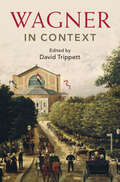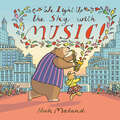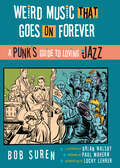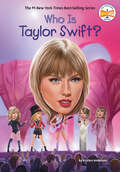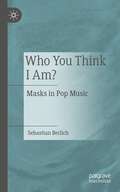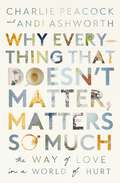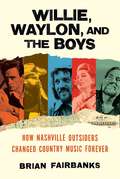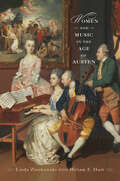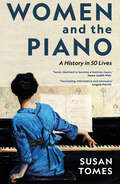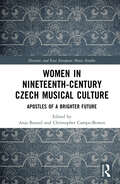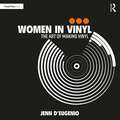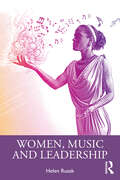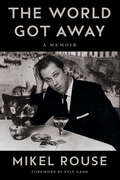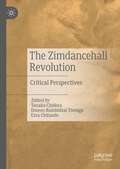- Table View
- List View
Wagner in Context (Composers in Context)
by David TrippettFew composers embodied wider cultural interests than Wagner or had greater cultural consequences. This is the first collection to examine directly the rich array of intellectual, social and cultural contexts within which Wagner worked. Alongside fresh accounts of historical topics, from spa culture to racial theory, sentient bodies to stage technology, America to Spain, it casts an eye forward to contexts of Wagner's ongoing reception, from video gaming to sound recording, Israel to Friedrich Kittler, and twenty-first century warfare. The collection brings together an international cast of leading authorities and new voices. Its 42 short chapters offer a reader-friendly way into Wagner studies, with authoritative studies of central topics set alongside emerging new fields. It sheds new light on previously neglected individuals such as Minna Wagner, Theodor Herzl and Houston Stewart Chamberlain, and investigates/assesses/examines the global circulation of Wagner's works, his approach to money, and the controversies that continue to accompany him.
We Light Up the Sky with Music!
by Nick MalandThis tender tale of showing care to a loved one will resonate with anyone who has ever found joy and purpose in music.Old Bear sits inside, staring at gray skies. He hasn't gone outside in quite a while. So Little Bear decides it's time for a walk! The weather is windy and Old Bear isn't thrilled to be outdoors, but Little Bear coaxes him, &“Let&’s walk a little further.&” Then, suddenly, a curious noise catches both of their ears—an old saxophone lying in the alleyway! Can it be restored? Perhaps a bit of good company and teamwork is just what Old Bear could use to find his groove again.
Weird Music That Goes on Forever: A Punk's Guide to Loving Jazz
by Bob SurenOnce you've collected every 7" from your favorite label, broken your back in the mosh pit, and become so well-versed in the interpersonal dynamics of every hardcore band that there's nothing more to learn, what's a punk to do? Try jazz, recommends Bob Suren. No, really. Suren, who wrote Crate Digger about his life and work in punk, turns his obsessive gaze onto another form of rebellious, improvisational outsider music, but this time with more sax.What does Dixieland have in common with D.R.I.? Did Charles Mingus write the first punk song? And who was the Butthole Surfer of jazz? Suren answers these questions and many more. Reading his irreverent guide to jazz, filled with punk references and colorful language, is more fun than getting arrested for vandalism. Learn about the surprising history and scandalous etymology of jazz, explore its connections to punk, and take in biographical sketches of over 25 notable artists—with plenty of recommendations thrown in for your listening pleasure.
Who Is Taylor Swift? (Who Was?)
by Kirsten Anderson Who HQLearn how a young girl who lived on a Christmas tree farm grew up to become one of the most celebrated musical artists of the twenty-first century in this addition to the #1 New York Times bestselling series.Taylor Swift always knew she wanted to be a country music artist, so at age thirteen, she convinced her parents to move their family out of Pennsylvania to Nashville.As a singer, songwriter, and guitarist, Taylor wrote songs about teenage heartbreak and fitting in with her peers, and she performed these and other tunes at open mic nights and karaoke events. Breaking into the music industry took longer than she expected because record executives thought there was no place in country music for her songs. But Taylor was fearless and proved them wrong.Since the release of her self-titled debut album in 2006, Taylor Swift has dominated the music charts, reinvented her sound, won numerous awards, shaken off public criticism, and spoken up for herself and others. Whether you're a lifelong Swiftie or someone who just loves learning about musicians, this enchanting book will teach you all about the experiences that helped Taylor Swift become the successful superstar many kids and adults looks up to.
Who You Think I Am?: Masks in Pop Music
by Sebastian BerlichPop stars are close to us. In their songs, their pictures, their stories on Instagram. What we are looking for is an authentic impression. Real feelings on real faces. But what happens when they cover their face with a mask? Permanently, as a second face. The phenomenon can be found in the mainstream as well as in the underground. The mask does not break with the ideal of authenticity. Rather, depending on how it is staged, it refers to the most diverse discourses, can appear cool or grotesque, become a logo or create anonymity. The essay uses mainly two examples (Sido, Slipknot) to show how the mask constructs the persona of pop stars - and thus reveals structures of pop music.
Why Everything That Doesn't Matter, Matters So Much: The Way of Love in a World of Hurt
by Andi Ashworth Charlie PeacockA hopeful and practical model for what it means to be a Christian and a culture-maker in a world of hurt and wondrous possibility, from multi–Grammy winner Charlie Peacock and his wife and author, Andi Ashworth.Do you feel powerless and overwhelmed by the pain and suffering all around you? Have you ever asked, What can I do to mend the world, my family, or my own life? And if I could, why bother? Does my own small part even matter? If so, here comes hope from two guides who are further down the road. Charlie and Andi have written a collection of letters to Christians and spiritual seekers who think deeply and care acutely about the state of the world and their personal spheres of influence.In Why Everything That Doesn't Matter, Matters So Much, beloved and trusted mentors, Charlie and Andi offer you:Thought-provoking explorations into the many facets of Christian culture care and making, from the kitchen to Carnegie Hall.Practical guidance for how to care for and improve the quality of human life, locally and globally, no matter your vocation.A theology of imagination and creativity that provides a framework for all of life.A model for expressing love in marriage, friendship, citizenship, and every kind of work—even in the midst of cynicism, fear, exhaustion, and oppression. It might be said of Christians that our lives are either moving in the direction of the redemption Jesus has on offer, or away from it. Each of these letters is a gentle nudge in the direction of God's powerfully ordinary purpose for each of us, no matter what the future holds, to participate fully in the beautiful, redemptive work of Christ.
Willie, Waylon, and the Boys: How Nashville Outsiders Changed Country Music Forever
by Brian FairbanksThe tragic and inspiring story of the leaders of Outlaw country and their influence on today&’s Alt-County and Americana superstars, tracing a path from Waylon Jennings&’ survival on the Day the Music Died through to the Highwaymen and on to the current creative and commercial explosion of Chris Stapleton, Brandi Carlile, Zach Bryan, Jason Isbell, and the Highwomen. On February 2, 1959, Waylon Jennings, bassist for his best friend, the rock star Buddy Holly, gave up his seat on a charter flight. Jennings joked that he hoped the plane, leaving without him, would crash. When it did, killing all aboard, on "the Day the Music Died," he was devastated and never fully recovered. Jennings switched to playing country, creating the Outlaw movement and later forming the Highwaymen supergroup, the first in country music, with Johnny Cash, Willie Nelson, and Kris Kristofferson. The foursome battled addiction, record companies, ex-wives, violent fans, and the I.R.S. and D.E.A., en route to unprecedented mainstream success. Today, their acolytes Kacey Musgraves, Ryan Bingham, Sturgill Simpson, and Taylor Swift outsell all challengers, and country is the most popular of all genres. In this fascinating new book, Brian Fairbanks draws a line from Buddy Holly through the Outlaw stars of the 60s and 70s, all the way to the country headliners and more diverse, up-and-coming Nashville rebels of today, bringing the reader deep into the worlds of not only Cash, Nelson, Kristofferson, and Jennings but artists like Chris Stapleton, Simpson, Bingham, and Isbell, stadium-filling masters whose stories have not been told in book form, as well as new, diverse artists like the Highwomen, Brittney Spencer, and Allison Russell. Thought-provoking and meticulously researched, Willie, Waylon, and the Boys ultimately shows how a twenty-one-year-old bass-playing plane crash survivor helped changed the course of American music.
Women and Music in the Age of Austen (Transits: Literature, Thought & Culture, 1650-1850)
by Pierre DuBois Kelly M. McDonald Danielle Grover Penelope Cave Simon Fleming Alison C. DeSimone Jane Girdham Leslie Ritchie Jeffrey A. Nigro Ruth Perry Devon R. Nelson Gayle Magee Juliette WellsWomen and Music in the Age of Austen highlights the central role women played in musical performance, composition, reception, and representation, and analyzes its formative and lasting effect on Georgian culture. This interdisciplinary collection of essays from musicology, literary studies, and gender studies challenges the conventional historical categories that marginalize women’s experience from Austen’s time. Contesting the distinctions between professional and amateur musicians, public and domestic sites of musical production, and performers and composers of music, the contributors reveal how women’s widespread involvement in the Georgian musical scene allowed for self-expression, artistic influence, and access to communities that transcended the boundaries of gender, class, and nationality. This volume’s breadth of focus advances our understanding of a period that witnessed a musical flourishing, much of it animated by female hands and voices. Published by Bucknell University Press. Distributed worldwide by Rutgers University Press.
Women and the Piano: A History in 50 Lives
by Susan TomesWomen are an essential part of the history of the piano—but how many women pianists can you name? Throughout most of the piano&’s history, women pianists lacked access to formal training and were excluded from male-dominated performance spaces. Even the modern piano&’s keys were designed without consideration of women&’s typically smaller hands. Yet despite their music being largely confined to the domestic sphere, women continued to play, perform, and compose on their own terms. Celebrated pianist and author Susan Tomes traces fifty such women across the piano&’s history. Including now-famous names such as Clara Schumann and Fanny Mendelssohn, Tomes also highlights overlooked women: from Hélène de Montgeroult, whose playing saved her life during the French Revolution, to Leopoldine Wittgenstein, influential Viennese salonnière, and Hazel Scott, the first Black performer in the United States to have a nationally syndicated TV show. From Maria Szymanowska to Nina Simone, and including interviews with women performing today, this is a much-needed corrective to our understanding of the piano—and a timely testament to women&’s musical lives.
Women in Nineteenth-Century Czech Musical Culture: Apostles of a Brighter Future (Slavonic and East European Music Studies)
by Anja Bunzel Christopher Campo-BowenThis volume focuses on the circumstances of women’s music-making in the vibrant and diverse environment of the Czech lands during the nineteenth century. It sheds light on little-known women musicians, while also considering more well-known works and composers from new woman-centric perspectives. It shows how the unique environment of Habsburg Central Europe, especially Bohemia and Lower Austria, intersects with gender to reveal hitherto unexplored networks that challenge the methodological nationalism of music studies as well as the discipline’s continued emphasis on singular canonical figures. The main areas of enquiry address aspects of performance and identity both within the Czech lands and abroad; women’s impact on social life with a view to different private, semiprivate, and public contexts and networks; and compositional aesthetics in musical works by and about women, analysed through the lens of piano works, song, choir music, and opera, always with the reception of these works in mind.
Women in Vinyl: The Art of Making Vinyl
by Jenn D’EugenioWomen in Vinyl: The Art of Making Vinyl provides a comprehensive guide to the world of vinyl, with a focus on empowerment, diversity, and inclusion, designed to both demystify the vinyl community and highlight the vital role women and minority groups play in shaping the industry.Divided into each step of the process, the book provides a detailed overview of the vinyl manufacturing process, from lacquer cutting, electroplating, and record pressing, to the roles of record labels, distribution, DJs, and more. With interviews and profiles from global professionals throughout, the book is a first-of-its-kind guide to the vinyl industry and the women who are blazing trails within it. Women in Vinyl is an essential resource for professionals, hobbyists, and students interested in the process of making vinyl, including those who want to deepen their understanding of the vinyl medium and its role in shaping the music industry, as well as for those interested in the work of the organization Women in Vinyl.
Women, Music and Leadership
by Helen RusakWomen, Music and Leadership offers a wide-ranging survey of women in musical leadership and their experiences, highlighting women’s achievements and considering how they negotiate the challenges of the leadership space in music. Women have always participated in music as performers, teachers, composers and professionals, but remain underrepresented in leadership positions. Covering women’s leadership across a wide variety of roles and musical genres, this book addresses women in classical music, gospel, blues, jazz, popular music, electronic music and non-Western musical contexts, and considers women working as composers, as conductors, and in music management and the music business. Each chapter includes several case studies of women’s careers, exploring their groundbreaking contributions to music and the challenges they faced as leaders. Connecting management theory and leadership research with feminist musicology, this book paints a new picture of women’s major contributions as leaders in music and their ongoing struggles for equity. It will be relevant to students and scholars in arts and music management, as well as all those studying music, gender or leadership, and women music professionals.
The World Got Away: A Memoir (Music in American Life)
by Mikel RouseOne of the most innovative composers of his generation, Mikel Rouse is known for a trilogy of operas that includes Dennis Cleveland and a gift for superimposing pop vernaculars onto avant-garde music. This memoir channels Rouse’s high energy personality into an exuberant account of the precarity and pleasures of artistic creation. Raconteur and starving artist, witty observer and acclaimed musician, Rouse emerged from the legendary art world of 1980s New York to build a forty-year career defined by stage and musical successes, inexhaustible creativity, and a support network of famous faces, loyal allies, and high art hustlers. Rouse guides readers through a working artists’ hardscrabble life while illuminating the unromantic truth that a project’s reception may depend on a talented cast and crew but can depend on reliable air conditioning. Candid and hilarious, The World Got Away is a one-of-a-kind account of a creative life fueled by talent, work, and luck.
You Don't Need a Dick to DJ
by Smokin JoBefore she became Smokin Jo - the most famous and visible of the first generation of 'superstar DJs' - Joanne Joseph was a young girl growing up in a children's home with her sister. Until her mother returned and whisked the siblings away just before secondary school to a flat on the Portobello Road, her life was devoid of music: the home didn't allow it, apart from hymns and carols at Christmas.As she entered the turbulent years of adolescence, Jo found herself pulled towards Soho and the burgeoning underground acid house scene, instantly finding herself at home amongst other artists, musicians and misfits who breathed and survived on dance music and ecstasy. Within a couple of years, in a lightning-fast ascent, Jo claimed her permanent place as one of England's most exciting and revered DJs of the British rave scene. In 1992, Jo was awarded DJ of the Year in DJ Magazine's list of Top 100 DJ's. To this day she is still the only woman to achieve this accolade.This alternately celebratory and brutal memoir tells a story full of change, growth and determination. It documents Jo's life and loves; her struggles with drink and drugs and journey towards peace and sobriety. It documents the highs and lows of rave culture in an unprecedented way through Jo herself: the elation and euphoria that comes with entertaining an audience as well as the misogyny, the racism, the prejudice and homophobia of the scene, as told by someone who has been at the hard end of these experiences. You Don't Need a Dick to DJ is an extraordinary, moving and unforgettable story from a pioneer and survivor; perhaps the most honest and startling memoir yet to emerge from the club scene.
The Zimdancehall Revolution: Critical Perspectives
by Tanaka Chidora Doreen Rumbidzai Tivenga Ezra ChitandoZimdancehall is a musical movement in Zimbabwe that has grown significantly since 2010. The Zimdancehall Revolution brings together critical essays on various aspects of Zimdancehall culture by scholars from diverse disciplines. Traditionally, music critics and senior academics have not taken Zimdancehall seriously, regarding it as vulgar, transient, bubble gum, lacking depth, and in short, a fad. There were also allegations that the lyrics influenced factionalism, incited violence and glorified drug use and unbridled promiscuity among the youth. This book affords this movement the protracted intellectual engagement that it deserves and argues that Zimdancehall is more than just a musical genre but an everyday culture, a way of life. The genre’s close association with the ghetto is telling and enables critics to look at it as a social movement, a revolution, or a raw, petulant and raging disturbance of peace by those who live their lives on the margins. It is, thus, a violent irruption onto the public space by marginalised young people whose presence as artistes creating art from the margins, simultaneously as victims and agents, circulating in a geography that escapes the limits of nationalist ideological and physical territory, in a way subverts communitarian prescriptions and allows young people entry into the world, albeit in a painful, tumultuous and violent way. The essays range from the mapping of the genre’s historical development to theoretical interventions in understanding the genre and its relationship with various aspects of the Zimbabwean society like politics, gender, religion, language, dance, cultural values and other genres.
